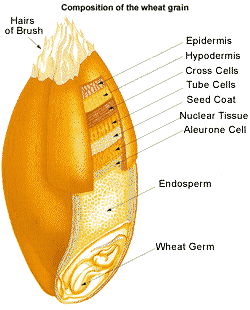|
|
|
|
Cooking Terms Explained -
Flour |
A
B
C
D
E
F
G
H
I
J
K
L
M
N
O
P
Q
R
S
T
U
V
W
X
Y
Z
What Is Flour?
 |
Flour is a fine
powder which is the result of grinding cereals such as wheat
between stones or metal. Although wheat is the principal source of
flour, other cereals such as maize (corn), rice and rye are also
used. Flour is the main ingredient of bread and pastry.
When flour is mixed with water the protein 'gluten' is produced
this gives dough (water and flour mixed) its elastic like
properties. The more gluten contained in the flour the stronger
will be the resulting dough. One property of dough that is very
important is its ability to contain air bubbles which gives dough
it's spongy and light texture when cooked. |
There is a huge variety of different varieties of flour suitable for
different uses. Most of the common varieties of flour available in
supermarkets are sold as fit for a specific purpose (e.g. cake flour, all
purpose flour, bread flour), each type of flour having specific
properties.
Cake Flour - this is a soft flour which is very low in gluten.
Pastry Flour - this is also a soft flour which has slightly more
gluten than cake flour.
Bread Flour - this is a hard flour which is high in gluten and
holds it's Shape well when cooked.
All Purpose Plain Flour - a blend of hard and soft flours with
medium gluten content.
Self-Raising Flour - this is All Purpose Plain flour which has
baking powder and salt mixed in. The baking powder helps the dough to
rise when it is cooked. You can make your own using the following
ingredients:
100 g plain flour
3 g baking powder
1 g salt
As well as the flours above there are other types of flour available
which are made from specific parts of the wheat grain. These are:
Whole Grain Flour - this is made from entire grain.
White Flour - is made from the endosperm part of the grain
Germ Flour - is made from the endosperm and germ part of the grain
but excludes the bran part.
Graham Flour - this is a wholewheat flour where the endosperm is
finely ground but the bran and germ are coarsely ground. Only commonly
found in the USA.
When flour is freshly milled it is naturally a light yellow colour. Over
time the flour will turn more white. Commercially though, freshly milled
flour is treated with bleaching agents to give it it's pure white colour.
These bleaching agents are normally organic peroxides like acetone
peroxide or benzoyl peroxide, nitrogen dioxide, or chlorine.
FLOUR FROM OTHER CEREALS
Corn flour - don't confuse this with the English cornflour (which is
cornstarch). This is popular in Mexico and southern USA. Masa harina is a
type of corn flour which is used to make the traditional tortilla of
Mexico.
Durum Flour - used almost exclusively to make noodles and pasta, it is
made from durum wheat.
Other sources of flour include rice, chickpea, rye, soy beans and
potatoes.
STORING FLOUR
Flour is prone to infestation with moths and beetles so correct storage
is essential. Keep flour in a cool, dry, dark place in a container that
allows the flour to breath. Avoid airtight containers.
FLOUR CAN BE EXPLOSIVE!
When fine flour is suspended in the air it is truly explosive. There have
been countless flour mill explosions over the last hundred years or so
killing many people. Although unlikely to happen in your home it is a
possibility to be aware of.
|
|
|

